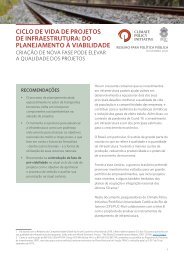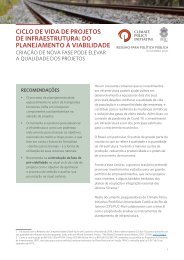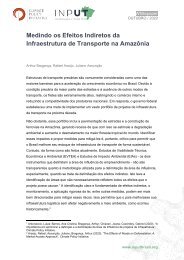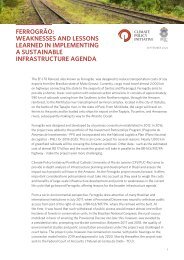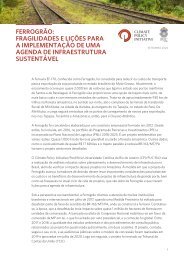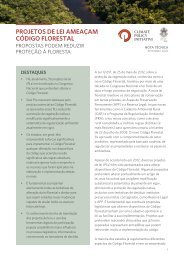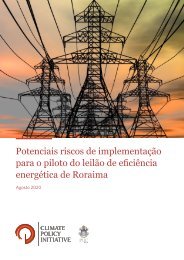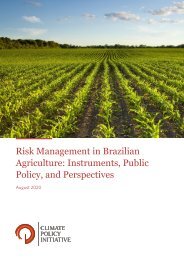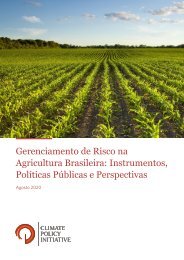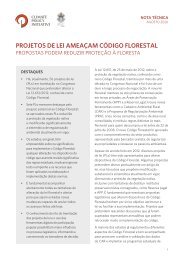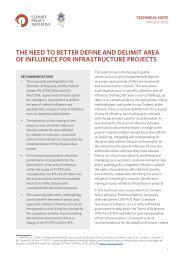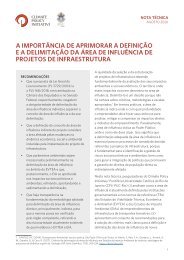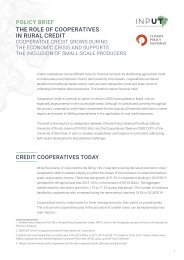Cattle-ranching-intensification-as-a-key-role-on-sustainable-agriculture-expansion-in-Brazil_Agroicone_INPUT
You also want an ePaper? Increase the reach of your titles
YUMPU automatically turns print PDFs into web optimized ePapers that Google loves.
CATTLE RANCHING<br />
L<strong>on</strong>g term visi<strong>on</strong> for cattle<br />
<str<strong>on</strong>g>ranch<strong>in</strong>g</str<strong>on</strong>g> <strong>in</strong> <strong>Brazil</strong>: impacts of<br />
Forest Code implementati<strong>on</strong> and<br />
deforestati<strong>on</strong> reducti<strong>on</strong><br />
L<strong>on</strong>g term and large scale implementati<strong>on</strong> of the<br />
Forest Code <strong>in</strong>cre<str<strong>on</strong>g>as</str<strong>on</strong>g>es the pressure <strong>on</strong> land use<br />
<strong>in</strong> <strong>Brazil</strong>, especially <strong>on</strong> beef cattle producti<strong>on</strong>.<br />
Three scenarios for 2035 were estimated<br />
us<strong>in</strong>g the <strong>Brazil</strong>ian Land Use Model - BLUM 1 :<br />
scenario without producti<strong>on</strong> area restricti<strong>on</strong>s<br />
– B<str<strong>on</strong>g>as</str<strong>on</strong>g>el<strong>in</strong>e Scenario; scenario with elim<strong>in</strong>ati<strong>on</strong><br />
of deforestati<strong>on</strong> from 2020 – Scenario DZ; and<br />
scenario with implementati<strong>on</strong> of the Forest Code<br />
comb<strong>in</strong>ed with the elim<strong>in</strong>ati<strong>on</strong> of deforestati<strong>on</strong><br />
from 2020 – Scenario CF (TABLE 1). In this<br />
l<str<strong>on</strong>g>as</str<strong>on</strong>g>t scenario, the possibility of a Legal Reserve<br />
compensati<strong>on</strong> market w<str<strong>on</strong>g>as</str<strong>on</strong>g> c<strong>on</strong>sidered (through<br />
envir<strong>on</strong>mental serfdom <strong>in</strong> are<str<strong>on</strong>g>as</str<strong>on</strong>g> with rema<strong>in</strong><strong>in</strong>g<br />
native vegetati<strong>on</strong>), <str<strong>on</strong>g>as</str<strong>on</strong>g> proposed <strong>in</strong> the Forest Code.<br />
In the b<str<strong>on</strong>g>as</str<strong>on</strong>g>el<strong>in</strong>e scenario (TABLE 1), an<br />
<strong>in</strong>cre<str<strong>on</strong>g>as</str<strong>on</strong>g>e of 6.8 milli<strong>on</strong> hectares <strong>in</strong> the area<br />
allocated for <strong>agriculture</strong> w<str<strong>on</strong>g>as</str<strong>on</strong>g> estimated <strong>in</strong><br />
2035 relative to 2010, c<strong>on</strong>sider<strong>in</strong>g c<strong>on</strong>t<strong>in</strong>uous<br />
TABLE 1. LAND USE RESULTS IN BRAZIL FOR SCENARIOS<br />
SIMULATED IN THE BRAZILIAN LAND USE MODEL - BLUM<br />
Area <strong>in</strong> thousand ha/<br />
B<str<strong>on</strong>g>as</str<strong>on</strong>g>el<strong>in</strong>e<br />
Difference<br />
Productivity <strong>in</strong> kg/ha<br />
Producti<strong>on</strong><br />
DZ - B<str<strong>on</strong>g>as</str<strong>on</strong>g>el<strong>in</strong>e CF - B<str<strong>on</strong>g>as</str<strong>on</strong>g>el<strong>in</strong>e<br />
2010 2025 2035<br />
(thousand t<strong>on</strong>s)<br />
2025 2035 2025 2035<br />
Summer crop are<str<strong>on</strong>g>as</str<strong>on</strong>g> a 46,444 61,104 66,896 -204 -291 -1,557 -2,114<br />
P<str<strong>on</strong>g>as</str<strong>on</strong>g>ture are<str<strong>on</strong>g>as</str<strong>on</strong>g> 182,661 168,552 164,244 -271 -2,147 -5,521 -11,034<br />
Land use<br />
(total area) b 235,855 240,281 242,716 -475 -2,438 -7,078 -13,148<br />
Beef producti<strong>on</strong><br />
(thousand t<strong>on</strong>s)<br />
9,365 12,111 13,506 -226 -3 -134 -286<br />
Producti<strong>on</strong> of meat per<br />
hectare (kg/ha)<br />
51.27 70.41 81.23 -1.23 1.07 1.61 4.06<br />
Producti<strong>on</strong> of gra<strong>in</strong>s*<br />
(thousand t<strong>on</strong>s)<br />
148,892 261,130 322,363 -178 -364 -1,503 -2,778<br />
Source: Agroic<strong>on</strong>e/results of the study. Notes: a) Summer crops (or 1 st harvest crops) c<strong>on</strong>sidered: rice,<br />
beans (summer area), corn (summer area), soybeans, cott<strong>on</strong> and sugarcane; b) Land use is the sum of<br />
are<str<strong>on</strong>g>as</str<strong>on</strong>g> of 1 st harvest crops, commercial forests and p<str<strong>on</strong>g>as</str<strong>on</strong>g>tures; c) W<strong>in</strong>ter crops (or 2 nd harvest) c<strong>on</strong>sidered:<br />
beans (w<strong>in</strong>ter area), corn (sec<strong>on</strong>d harvest), wheat and barley.<br />
1. The methodological descripti<strong>on</strong> of BLUM can be found <strong>in</strong> ICONE (2014). The scenario simulati<strong>on</strong>s with<br />
BLUM were carried out <strong>in</strong> June of 2015 and revised <strong>in</strong> April of 2016. https: /goo.gl/F2ujjq<br />
decre<str<strong>on</strong>g>as</str<strong>on</strong>g>es <strong>in</strong> deforestati<strong>on</strong> rates. <str<strong>on</strong>g>Cattle</str<strong>on</strong>g> <str<strong>on</strong>g>ranch<strong>in</strong>g</str<strong>on</strong>g><br />
should reduce p<str<strong>on</strong>g>as</str<strong>on</strong>g>ture are<str<strong>on</strong>g>as</str<strong>on</strong>g> by 18.4 milli<strong>on</strong><br />
hectares <strong>in</strong> the same period, be<strong>in</strong>g substituted<br />
by summer crops and planted forests and, thus,<br />
significantly reduc<strong>in</strong>g the need to <strong>in</strong>corporate new<br />
are<str<strong>on</strong>g>as</str<strong>on</strong>g> for producti<strong>on</strong> expansi<strong>on</strong>. An important<br />
technological advance <strong>in</strong> cattle <str<strong>on</strong>g>ranch<strong>in</strong>g</str<strong>on</strong>g> might<br />
occur, reduc<strong>in</strong>g low productivity are<str<strong>on</strong>g>as</str<strong>on</strong>g> and<br />
<strong>in</strong>cre<str<strong>on</strong>g>as</str<strong>on</strong>g><strong>in</strong>g producti<strong>on</strong> per hectare by 58% <strong>in</strong> the<br />
same period. In the aggregate b<str<strong>on</strong>g>as</str<strong>on</strong>g>el<strong>in</strong>e scenario,<br />
it is estimated that cattle <str<strong>on</strong>g>ranch<strong>in</strong>g</str<strong>on</strong>g> will require<br />
annual <strong>in</strong>vestments of US$ 5.7 billi<strong>on</strong> <strong>in</strong> the next<br />
25 years (from 2010 to 2035 <strong>in</strong> 2014 values; R$/<br />
US$ 3.10) <strong>in</strong> order to <strong>in</strong>cre<str<strong>on</strong>g>as</str<strong>on</strong>g>e productivity.<br />
In alternative scenarios, DZ and CF, the<br />
reducti<strong>on</strong> of p<str<strong>on</strong>g>as</str<strong>on</strong>g>ture are<str<strong>on</strong>g>as</str<strong>on</strong>g> might be even<br />
higher, 2.1 milli<strong>on</strong> and 11 milli<strong>on</strong> hectares more,<br />
respectively, compared to the b<str<strong>on</strong>g>as</str<strong>on</strong>g>el<strong>in</strong>e scenario <strong>in</strong><br />
2035. The ec<strong>on</strong>omic dynamics expla<strong>in</strong>s this result:<br />
the low profitability of cattle <str<strong>on</strong>g>ranch<strong>in</strong>g</str<strong>on</strong>g> compared<br />
to crops’ returns, which crops expansi<strong>on</strong> displaced<br />
p<str<strong>on</strong>g>as</str<strong>on</strong>g>turelands and Forest Code compliance also<br />
pushed p<str<strong>on</strong>g>as</str<strong>on</strong>g>ture and cattle <str<strong>on</strong>g>ranch<strong>in</strong>g</str<strong>on</strong>g> <str<strong>on</strong>g><strong>in</strong>tensificati<strong>on</strong></str<strong>on</strong>g>,<br />
s<strong>in</strong>ce land use expansi<strong>on</strong> w<str<strong>on</strong>g>as</str<strong>on</strong>g> restricted.<br />
Beef producti<strong>on</strong> is<br />
estimated to reach 12 milli<strong>on</strong><br />
t<strong>on</strong>s <strong>in</strong> 2025 and 13.5 milli<strong>on</strong><br />
t<strong>on</strong>s <strong>in</strong> 2035, represent<strong>in</strong>g<br />
a 44% growth <strong>in</strong> 25 years.<br />
Similar results were found <strong>in</strong><br />
alternative scenarios, with a<br />
small negative impact <strong>on</strong> beef<br />
producti<strong>on</strong> of up to 3% (<strong>in</strong> the<br />
c<str<strong>on</strong>g>as</str<strong>on</strong>g>e of the most restrictive<br />
scenario <strong>in</strong> terms of land use –<br />
CF), but with higher beef prices.<br />
The annual <strong>in</strong>vestment<br />
<strong>in</strong> alternative scenarios for<br />
the period between 2010 and<br />
2035 should <strong>in</strong>cre<str<strong>on</strong>g>as</str<strong>on</strong>g>e <strong>in</strong> up<br />
to US$ 387 milli<strong>on</strong> per year<br />
10



